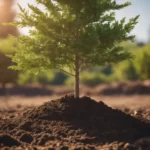Fruit trees are a valuable asset to any garden, offering both aesthetic beauty and a source of fresh produce. However, squirrels can pose a significant challenge, often damaging trees and pilfering fruit. Understanding how to effectively protect your fruit trees from these agile creatures is crucial for ensuring a healthy and abundant harvest.
Squirrel Behavior
To effectively combat the issue, it’s important to understand why squirrels are attracted to fruit trees. Squirrels are primarily drawn to fruit trees for the food they provide, particularly during certain seasons when other food sources are scarce. They are known for their agility and persistence, capable of jumping significant distances and climbing smooth surfaces to access food. Recognizing these behaviors is key to implementing effective deterrent strategies.
Physical Barriers and Deterrents
Physical barriers can be one of the most effective ways to protect fruit trees from squirrels.
Installing Netting or Fruit Tree Sleeves
- Netting or specially designed fruit tree sleeves can be draped over the tree to prevent squirrels from accessing the fruit. Ensure the netting is secured at the bottom to stop squirrels from getting under it.
- Consider the size of the mesh to allow for light penetration and air circulation while still keeping squirrels out.
Using Metal Collars or Wraps Around Tree Trunks
- Metal collars or wraps around the trunk can prevent squirrels from climbing the trees. These barriers should be placed high enough to be out of jumping range and wide enough to be difficult for squirrels to bypass.
- Regularly check and adjust these barriers to accommodate tree growth.
The Effectiveness of Tree Baffle Systems
- Baffle systems, typically cone or cylinder-shaped, can be installed on the trunk to prevent squirrels from climbing up to the branches.
- Ensure baffles are positioned correctly for maximum effectiveness, typically at least 5-6 feet off the ground.
Cultural Practices for Squirrel Management
Adopting certain cultural practices can significantly reduce the allure of fruit trees to squirrels. These methods focus on making the environment less inviting or accessible.
Pruning Techniques
- Strategic pruning can help. Remove low-hanging branches to make trees harder to access from the ground.
- Create a more open canopy, which can deter squirrels who prefer moving in more concealed spaces.
Keeping the Area Around Fruit Trees Clean
- Regularly clean up fallen fruits, nuts, and other debris around the tree base. This reduces the food sources available to squirrels on the ground.
- Maintain a tidy and less dense undergrowth to discourage squirrels from nesting or hiding near your fruit trees.
Strategies for Disposing of Fallen Fruits Promptly
- Collect and dispose of fallen fruits daily during the harvest season. This not only deters squirrels but also helps in preventing diseases and pests that can affect the tree and fruit.
Repellents and Deterrents
Various commercial and homemade repellents can be used to deter squirrels. However, their effectiveness can vary and often requires regular application.
Overview of Commercial and Homemade Squirrel Repellents
- Commercial repellents usually contain predator urine or spicy substances that squirrels find unpleasant.
- Homemade repellents can include a mix of cayenne pepper, garlic, and water. It’s important to reapply these solutions frequently, especially after rain.
Effective Use of Motion-Activated Sprinklers or Ultrasonic Devices
- Motion-activated sprinklers can startle and deter squirrels when they approach.
- Ultrasonic devices emit sounds that are uncomfortable for squirrels but are inaudible to humans.
Limitations and Considerations When Using Repellents
- Some repellents may lose effectiveness over time as squirrels become accustomed to them.
- Always consider the safety and impact on other wildlife and pets when using these products.
Alternative Food Sources
Providing alternative food sources can divert squirrels’ attention away from your fruit trees. This method involves a bit of strategy in terms of placement and choice of food.
Setting Up Feeding Stations
- Establish feeding stations for squirrels at a distance from your fruit trees. Foods like nuts, seeds, and corn can be more appealing to them than your fruit.
- Regularly replenish these feeding stations, especially during the peak fruiting season of your trees.
Impact of Supplemental Feeding
- While supplemental feeding can attract squirrels away from your trees, it can also encourage more squirrels to visit your garden. Monitor the situation to ensure it doesn’t exacerbate the problem.
Biological Control Methods
Encouraging the presence of natural predators can be an effective way to control squirrel populations.
Encouraging Natural Predators
- Birds of prey, such as hawks and owls, are natural predators of squirrels. Installing nesting boxes may help attract these birds to your garden.
- Ensure that your garden is welcoming to these predators by maintaining a habitat conducive to their needs.
Role of Pets
- Dogs and cats can be effective at deterring squirrels. Their presence and movement in the garden can keep squirrels at bay.
Legal and Ethical Considerations
When dealing with wildlife, such as squirrels, it’s important to be mindful of legal and ethical considerations.
Local Wildlife Laws and Regulations
- Check local regulations regarding wildlife control. Some areas have specific guidelines on how to deal with squirrels humanely.
- Avoid methods that could harm squirrels or other wildlife.
Ethical Considerations
- Focus on humane and non-lethal methods for deterring squirrels.
- Remember that squirrels are an integral part of the ecosystem and should be treated with respect.
Conclusion
Protecting fruit trees from squirrels involves a combination of strategies, from physical barriers to cultural practices and the use of repellents. While no single method guarantees complete protection, a combination approach increases the chances of success. Remember to adapt your strategies based on the effectiveness and observe the behavior of squirrels in your garden. With patience and persistence, you can enjoy the fruits of your labor without significant loss to these agile creatures.



